Creating Clementine

This year’s most beloved protagonist isn’t a war hero, assassin, or space marine; she’s an eight-year-old girl. Yes, there’s something about Clementine, and when she stepped onto the screen in Telltale’s The Walking Dead with her oversized blue-and-white baseball cap, messy hair, wide eyes, and angelic voice, everything changed. This zombie apocalypse is different; it isn’t about mindlessly killing zombies, escaping from Boomers, or hiding out in a mall. The experience centers on keeping one little girl safe, and we do things we never imagined we’d do just to hear her speak another line of dialogue.
Clementine isn’t just a collection of polygons on a television screen. She’s broken through the barrier, securing a place in the hearts of many – a feat most video game characters never accomplish. How did Telltale create one of the most magnetic characters to grace our TV screens? We sat down with some of the masterminds behind Clementine at Telltale – writer and creative lead Sean Vanaman, art director Derek Sakai, and voice actress Melissa Hutchison – to discover how one little girl came to life and became a beacon of light in a hopeless journey.
[This feature originally appeared in Game Informer issue #237]
The Beginning
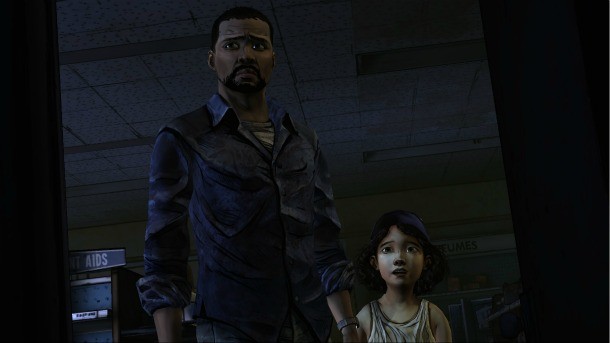
Though Lee Everett is the character you control in The Walking Dead, he wasn’t the character that the game is built around. “Clementine was literally the first idea,” says Vanaman, who planned Episode Fives’s outcome before writing a single line of dialogue. Vanaman had plenty of reasons to focus on a child, since Robert Kirkman, writer of the original comic series, never shied away from involving kids in his dark tale. However, convincing his Telltale cohorts to use a young girl in such an intense setting wasn’t an easy sell. Vanaman says, “Getting people internally excited about it was really challenging.... There’s no kid I can point to in a video game and say, ‘It’s going to be just like that person, don’t worry about it.’” Soon enough, the reservations lifted, surprising even Vanaman. “People recognized the hurdle set forth by deciding there’s going to be this little girl that’s going to be a key feature of the game, but people kept saying yes anyway.”
|
Changing Clementine Lee Everett wasn’t Telltale’s first idea for a main character. Originally, Vanaman planned for Clementine to come from a single-parent household where Clementine’s brother took care of her due to her mother not being up for the task. With this idea, Clementine’s brother became the lead, but Vanaman decided a pre-existing relationship would be too much to ask a player to take on in The Walking Dead world. The decision led to them changing Clementine’s race because they wanted her to look like she could potentially be Lee’s daughter. |
The next step was shaping Clementine’s personality. “From the beginning, the designers knew they wanted a character that would act as a moral compass for the main character as he progressed through the game,” says art director David Sakai. “The designers envisioned a smart, honest, and capable girl around eight years old.”
Clementine also had to be imaginative and precocious, which lead to giving her a hideout: the treehouse. “She’s already strong enough to isolate herself from her parents, knowing that her relationship with her parents is so strong that she can always come back inside,” Vanaman says. Since most of what’s been revealed about Clementine’s parents is from a phone message, it’s surprising to discover just how much influence they had in Vanaman’s creation of Clementine. “I wanted her parents to be the sort of parents I aspire to be one day. That informed who she was to me,” Vanaman says. “I really designed her parents before designing who she was. We did that before she was the Clementine in the game.”
Her parents also factored into creating her iconic blue-and-white baseball hat with the letter “D.” Vanaman wanted Clementine to have something she held onto as a constant reminder of her parents and their impact on her. After talking to Sakai, the idea for the hat was born. Sakai drew inspiration for much of Clementine’s design from his young daughter, who wears a similar cap. “She’s got a crazy sense of fashion that oddly translates well into the world of The Walking Dead. My daughter won’t accept advice from anyone when it comes to her outfits. For example, she’ll combine her favorite dress with her older brother’s baseball cap and then refuse any shoes at all,” Sakai says. “Clementine doesn’t have parents to tell her what to wear, so her outfits needed to reflect a child’s idea of appropriate clothing.”
During the process Vanaman turned to Sakai’s experience with fatherhood for advice. Sakai gave him some sage words that shaped Clementine’s dialogue: “The less my kids talk, the smarter I think they are.” Vanaman took the advice to heart. “I strike through a lot of Clementine lines with a red pen before they get into the game,” he says. That wasn’t the limit of Sakai’s wisdom about children, as he also imparted his thoughts about a child’s honesty. “My daughter was a major inspiration for me because she is always telling me my business,” Sakai says. “She is only five, but if I step out of line she is always the first to call me on it.”
Finding a Voice
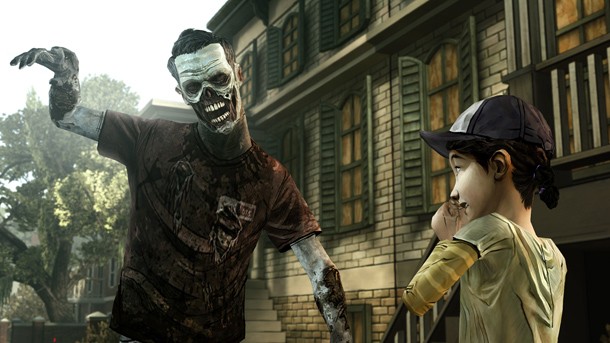
With the concept and design in place, the last piece of the puzzle was finding the perfect voice actress, a task that was more difficult than anticipated. Children auditioned, but they couldn’t grasp the emotional complexity of the part. Adults didn’t sound like what Vanaman and his team envisioned for Clementine. The auditions took so much of a toll that Telltale wondered if the character they spent so much time crafting would even work. “We thought we were going to have to take Clementine out of the game,” Vanaman says.
Thankfully, fate intervened in the form of Melissa Hutchison, a veteran voice actress who had worked on past Telltale games like Sam & Max and Back to the Future, as well as the cult hit Deadly Premonition. Once Hutchison came into audition, everything clicked on both ends. “We got the auditions for Episode 1, and when I read Clementine’s character description, it struck this chord in me,” Hutchison says. “I really related to Clementine. Her personality description kind of matched that of my own when I was a child, sans the zombie apocalypse thing.” Acting like a child came naturally for Hutchison, but she still prepped for her role. “I study people. I mimic people – personalities, movements, facial expressions. I keep them inside of this library in my head. Clementine is a result of that,” she says. Every detail she observed in children she put into Clementine, right down to how kids pause, stutter, and add breaths between words.
“[Once] Derek [Sakai] draws an incredibly captivating little girl and you get Melissa Hutchison to do just this perfect voice, it does so much of the work for you,” Vanaman says. “And now, it’s like, ‘Okay, we just write the game and try not to screw it up so bad.’”
Cementing the Bond
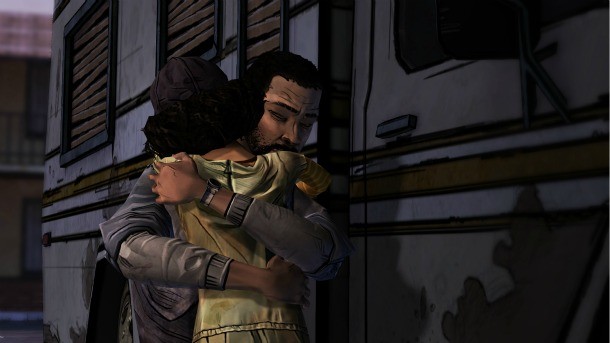
Now that the foundations for Clementine’s character were set, the next challenge was forging a bond between two strangers that would become one of the most treasured relationships in The Walking Dead. “Lee and [Clementine] are the main characters, so I wanted to get them together as fast as possible,” Vanaman says. “The first character you meet is the one you’re going to care about, the first thing on your brain.”
Clementine’s first scene and interaction with Lee were instinctual for Vanaman. He walked the player into a story that’s been going on for three days: Clementine having a territorial battle with her zombified babysitter. This introduction imbued Clementine with some specific traits: “We needed you to instantly like her, so she saves your life,” Vanaman says,“We needed her to be resourceful, so she brings you something very specific to save your life. We needed her to be vulnerable, so she’s afraid while you’re killing her babysitter.”
This sequence perfectly set up Clementine’s role in the story, but did Vanaman have any reservations pairing her with Lee, a convict? “No, I knew Lee just had to feel in his soul like a good man, and I feel like we do that,” he says. A safe haven existed because the player was controlling and shaping Lee throughout the process while a bond with Clementine deepened. “The whole backbone of the story is the relationship between Lee and Clementine, and the choices Lee makes in order to protect Clementine,” Hutchison says. “If Clementine came off annoying, people would be trying to find the button that sends her straight into a herd of walkers.”
Having Lee and Clementine’s instantaneous connection build even deeper throughout the episodes has been a high point of the game, but it also serves as part of the conflict. “We knew who they are as they grew together was going to cause problems,” Vanaman says. “It’s a tragic relationship.” The doubt surrounding her parents’ survival preys on you. A best case scenario doesn’t really exist — if her parents are dead, that’s tragic for Clementine. And if they’re alive? What does that mean for Lee? You’re growing the whole time with Clementine, but the context of the relationship pulls them apart, as we saw in Episode 4 when Clementine grows frustrated with Lee not looking for her parents in Savannah.
[Next Up: Clem gets under our skin, fans shower her with adoration, and how she's catapulted the series into something more...]
The Emotional Pull
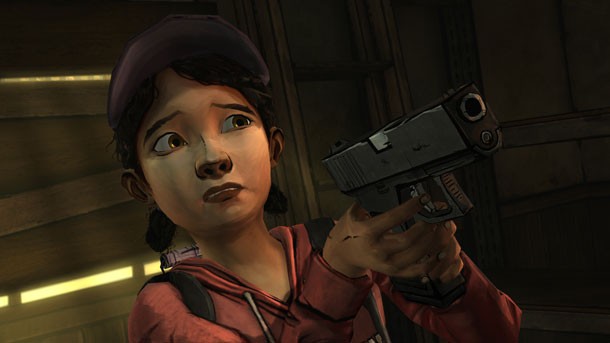
How can one character grip such a wide range of people? What is it about Clementine that keeps us trudging through such a tragic tale? Perhaps we just want to believe that good prevails. “Clementine is meant to represent innocence and purity,” Sakai says. “She embodies the main character’s desire to protect and preserve what is good about humanity.”
But it goes deeper than that. We’re watching an eight-year-old girl lose her innocence and experience the darker side of the world through gruesome deaths. The fantasy of happy endings is destroyed for her as she realizes in Episode 4 she may never return to school. Her wardrobe also changes to further enforce her vanishing naivety, “At the beginning she is wearing a sweet clean summer dress, but as the game progresses, her dress becomes dirty and bloody, and reflects her loss of innocence and Lee’s inability to shelter her from their grim reality,” Sakai says.
|
The Infamous Haircut Episode 3 was by far the most shocking in the death department, but one other big event happened: Clementine’s precious hair got chopped. Vanaman knew it was a big move and was doubtful if people would get behind it, but he knew it fit well in the storyline. Lee had just seen a child die and Vanaman wanted the realization to sting that it could have been Clementine. He made a list of everything about Clementine he thought was a liability - like the fact that she couldn’t shoot a gun – but then realized another big one existed: zombies grabbed her hair in the past. Once he approached Sakai about it, Vanaman was surprised by just how much he liked her new look, “I liked her silhouette more – you saw her face; it wasn’t just this mop anymore,” he says. |
This humanization of the story draws people in. “So much of the greater story is about families, parents, and kids. That stuff is really powerful,” Vanaman says. “If we execute on that honestly then you’re going to hopefully connect.” Clementine’s desire to see her parents and faith that they’re alive even while people around her are dying showcases this childhood optimism. “Even if the players don’t have a daughter of their own,” Sakai says, “they can identify with Clementine’s fear of never seeing her parents again.”
From the beginning no character’s fate has been guaranteed, which is part of what Vanaman admires about the unsettling tale. “That’s what the story does in The Walking Dead, you have to be afraid of it,” he says. Keeping players invested in Clementine has always centered on her safety, but because of the precedents Kirkman set in The Walking Dead comics, the door is open to torture players with Clementine’s life. “Kids are treated just like adults in the narrative. Kirkman...he will kill a kid in an instant [without hesitation],” Vanaman says.
The emotional toll of the unpredictable narrative has certainly tested Hutchison. “I can actually say that this is the first job in my voice-over career that has actually brought me to actual, physical tears,” she says.
Attached Fans
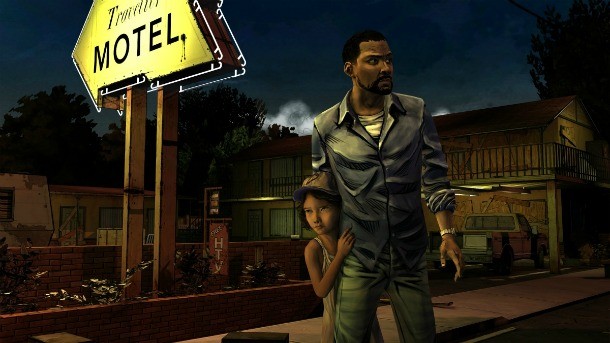
Clementine quickly became the star of The Walking Dead, and ever since she’s been showered with fanfare. Right now, Telltale has a #ForClementine hashtag on Twitter where fans express just how far they’d go for her. Telltale has seen it all, from Clementine cosplayers to beautiful fan art all in the name of one little girl. The reaction is something Vanaman wasn’t quite prepared for, but he’s happy with the result. “The fact that people care about Clementine is invaluable.” Fans are so passionate and emotionally-invested that they often react to her like she’s a real person. Hutchison says, “I have seen people get downright pissed at other characters in the game if they try to put Clementine in dangerous situations. It is awesome to see how protective people have become of her.”
The response has forced Telltale to consider the question: Does having someone that people have taken such a liking to change the vision for the character? “No. It can’t. It’s a dark path.... It’s so tough,” Vanaman says. “You have to dance with the date that brought you. The game is doing well, so I don’t want to muck with the plan. I’m afraid to do that.” While Vanaman hasn’t changed any of his plans for Clementine, he did realize he had to make decisions about her with more care. He says, “You have to be a little bit more careful because people care so much.”
The team at Telltale is also very aware of how much Clementine dictates players’ choice. Vanaman spoke of data that confirms player’s decisions often change depending whether or not Clementine is in the scene. “That’s a pretty big power. You have to be judicious, and with great power comes great responsibility,” Vanaman says. Clementine only enters the mix for weighty decisions, but it’s never done to try and force the player’s hand. He says, “You can’t be cavalier about it, otherwise you guys will totally stop trusting us and see right through us.”
The fans aren’t the only ones getting attached to Clementine. Hutchison even confesses to having a strong connection with her, especially since this is longer than she usually gets to spend voicing a character. “She has become my own, my love, my precious,” she says. “I too have become very protective of her.”
A Ray of Light in Video Game Writing

From the moment Clementine stepped on the screen, she pulled us into her world. We’ve watched her grow, cheering her on as she finds herself, fearing we won’t always be a part of her life. Few characters provoke such an investment, but Clementine broke through the slew of generic characters on our screens, providing something deeper for players. Like a voice of morality, Clementine has been with us all along, trying to prove good can overcome even the most vicious circumstances.
“She is like this little light of innocence and hope in a world of doom and despair,” Hutchison says. Not many characters have -ignited the type of emotions that Clementine has for many, and that’s a testament to everything that went into her creation. As Sakai says, “I strongly believe it is the amalgamation of writing, voice acting, acting/animation, and the art working together that brings out her appeal. If any one of those areas fell short she would be off-putting to the player.”

Get the Game Informer Print Edition!
Explore your favorite games in premium print format, delivered to your door.
- 10 issues per year
- Only $4.80 per issue
- Full digital magazine archive access
- Since 1991









